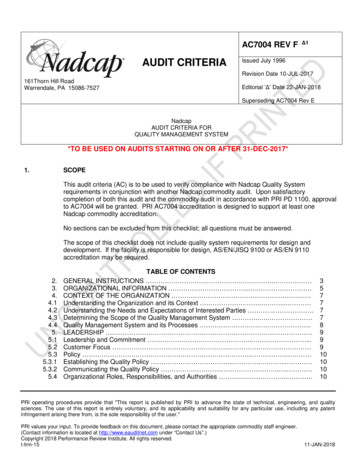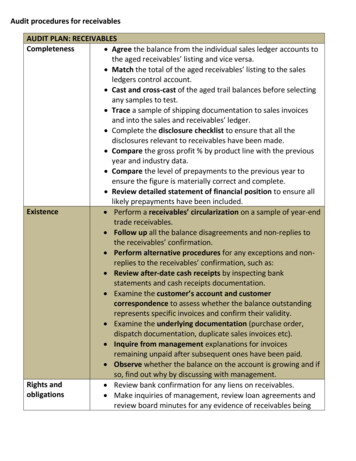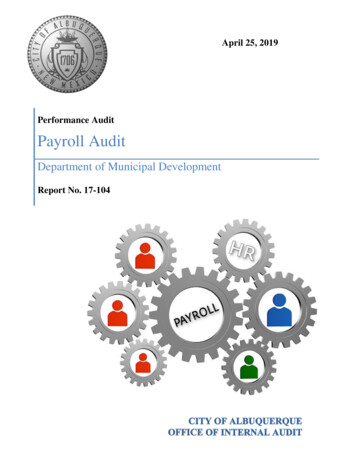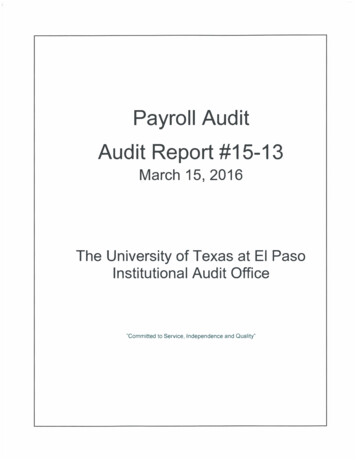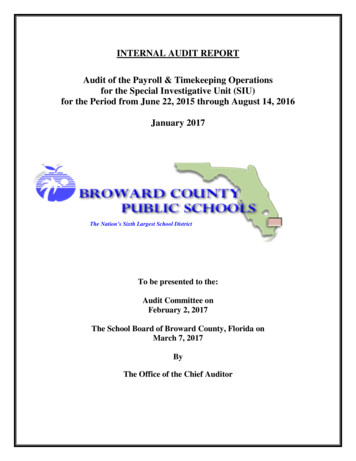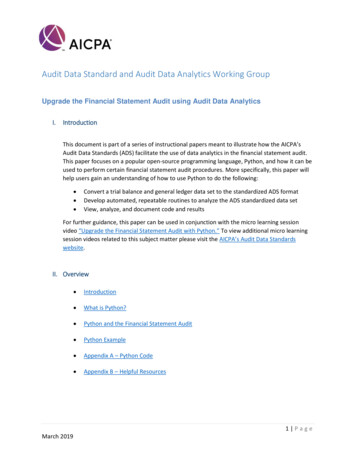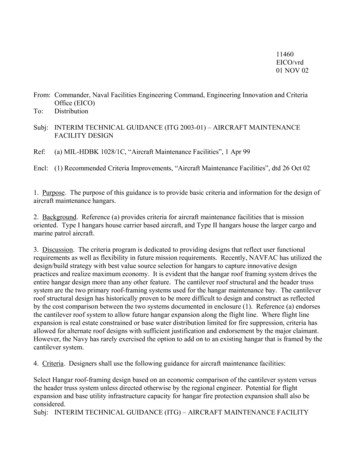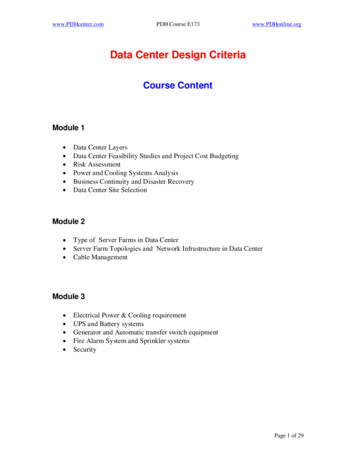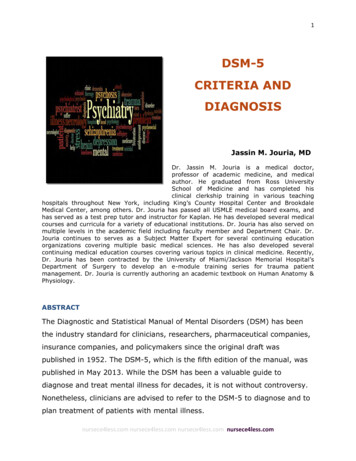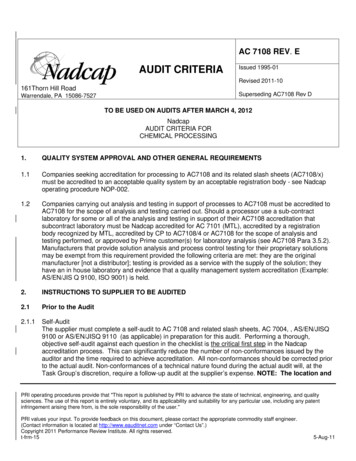
Transcription
AC 7108 REV. EAUDIT CRITERIAIssued 1995-01Revised 2011-10161Thorn Hill RoadSuperseding AC7108 Rev DWarrendale, PA 15086-7527TO BE USED ON AUDITS AFTER MARCH 4, 2012NadcapAUDIT CRITERIA FORCHEMICAL PROCESSING1.QUALITY SYSTEM APPROVAL AND OTHER GENERAL REQUIREMENTS1.1Companies seeking accreditation for processing to AC7108 and its related slash sheets (AC7108/x)must be accredited to an acceptable quality system by an acceptable registration body - see Nadcapoperating procedure NOP-002.1.2Companies carrying out analysis and testing in support of processes to AC7108 must be accredited toAC7108 for the scope of analysis and testing carried out. Should a processor use a sub-contractlaboratory for some or all of the analysis and testing in support of their AC7108 accreditation thatsubcontract laboratory must be Nadcap accredited for AC 7101 (MTL), accredited by a registrationbody recognized by MTL, accredited by CP to AC7108/4 or AC7108 for the scope of analysis andtesting performed, or approved by Prime customer(s) for laboratory analysis (see AC7108 Para 3.5.2).Manufacturers that provide solution analysis and process control testing for their proprietary solutionsmay be exempt from this requirement provided the following criteria are met: they are the originalmanufacturer [not a distributor]; testing is provided as a service with the supply of the solution; theyhave an in house laboratory and evidence that a quality management system accreditation (Example:AS/EN/JIS Q 9100, ISO 9001) is held.2.INSTRUCTIONS TO SUPPLIER TO BE AUDITED2.1Prior to the Audit2.1.1Self-AuditThe supplier must complete a self-audit to AC 7108 and related slash sheets, AC 7004, , AS/EN/JISQ9100 or AS/EN/JISQ 9110 (as applicable) in preparation for this audit. Performing a thorough,objective self-audit against each question in the checklist is the critical first step in the Nadcapaccreditation process. This can significantly reduce the number of non-conformances issued by theauditor and the time required to achieve accreditation. All non-conformances should be corrected priorto the actual audit. Non-conformances of a technical nature found during the actual audit will, at theTask Group’s discretion, require a follow-up audit at the supplier’s expense. NOTE: The location andPRI operating procedures provide that "This report is published by PRI to advance the state of technical, engineering, and qualitysciences. The use of this report is entirely voluntary, and its applicability and suitability for any particular use, including any patentinfringement arising there from, is the sole responsibility of the user."PRI values your input. To provide feedback on this document, please contact the appropriate commodity staff engineer.(Contact information is located at http://www.eauditnet.com under “Contact Us”.)Copyright 2011 Performance Review Institute. All rights reserved.t-frm-155-Aug-11
PRIAC 7108Revision E-2-identification of all applicable documentation must be indicated on the self-audit form. This willgreatly expedite the audit and avoid the expense of additional audit days.2.1.2Auditor ReviewRetain a copy of the self-audit on site for review by the Nadcap auditor when requested.2.1.3Required Audit Information:The information in questions 2.1.3.1 through 2.1.3.5 must be provided to the auditor, in English unlessanother language is acceptable to the auditor, at least 30 days prior to the scheduled audit:NOTE: No ITAR/EAR restricted materials are to be submitted.2.1.3.1 Original Self-AuditThe self-audit complete with procedure titles/procedure numbers for all documentation.2.1.3.2 Travelers/Route Cards.One sample traveler/route card for a process performed.2.1.3.3 List of Prime Customers and prime processing specifications in the scope of the audit.2.1.3.4 List of Supplier’s ProceduresList of supplier’s procedures (index/table of contents only) for processing, testing, inspection, etc.2.1.3.5 Organization ChartOrganization Chart2.1.4List of items that need to be presented to the auditor on arrival: Quality Control Manual. List of purchased services Schedule of calibrations, TUS, SAT, solution analysis etc. List of Quality personnel by process. List of trained personnel by process.2.2During the Audit2.2.1In-briefingThe supplier should provide for an in-briefing for the auditor and arrangements for a brief plant tourprior to the start of the audit. Key members of the applicant’s staff should attend the in-briefing so theaudit purpose, methods and assessment processes can be discussed.2.2.2Working SpaceWorking space for the auditor with desks or tables, chairs, telephone, etc. Clerical, typing andreproduction services are to be provided as required. This is not a full time assignment.2.2.3Out-BriefingA final out-briefing will be conducted at the completion of the audit. Each nonconformance report(NCR) will be reviewed and the supplier will be given the opportunity to discuss proposed correctiveaction or to provide any additional information. A copy of the NCR(s) will be provided to the supplier.NCR's deemed a non-conformance (e.g., a nonconformance to a requirement) are numbered. NCR'sthat are judged by the auditor to be a nonconformance to recommended practice are observations andare lettered. NOTE: The Chemical Processing Task Group may, upon review, change the auditor’sdetermination of non-conformance or observation.
PRIAC 7108Revision E-3-2.2.4Submittal of Corrective Actions/Objective EvidenceThe supplier shall have 21 calendar days to submit corrective actions, effective dates for each NCRalong with objective evidence of implementation. The response must address the root cause of thenonconformance from a systems management approach and the actions taken to preclude recurrence.2.2.5Delinquency of Corrective ActionsDelinquency of corrective actions and/or responses may result in failure of the audit, see NOP-011.If this is the first audit following a failed audit, verification of implementation of corrective actions for allnon-conformances from the failed audit is required. Repeat non-conformances from the failed audit areto be counted as non-sustaining NCRs.2.3Review of the Audit Report2.3.1ResponsibilityResponsibility for meeting submittal deadlines rests with the supplier. Failure to comply with specifieddates will result in significant delays in your accreditation and a reduction in the term of youraccreditation.A supplier representative should be available for questions during the final Task Group review to clarifyissues (either on site or by telephone).PRI Staff or the Task Group may, after review of your audit report, require additional information or mayelect to issue additional non-conformances. NOTE: Final authority over the audit report, acceptability ofcorrective actions, and accreditation recommendation rests with the Task Group.2.4Definition of Terms (See ISO2080 for general terms and definitions associated with chemicalprocessing)AMBIENT TEMPERATURE FOR PROCESS TANKS: Unless otherwise specified by customer,specification or technical data sheet, ambient is the natural uncontrolled temperature at thelocation of the tank and need not be monitored or controlledAUTOMATIC PROCESS LINE: A fully automatic process line is one in which all the variables of achemical process sequence are maintained, controlled and recorded by an automated, e.g.computer, system. Variables include (but are not limited to) solution immersion times, solutiontemperatures, step sequencing, and current/voltage settings. An automated process line does notrequire operator intervention to validate or monitor any part of the processing operation. Theoperator may be required to initiate, sequence or queue the specified, pre-established andprogrammed handling equipment or process, but does not alter or adjust the process variables,with the exception of halting a sequence that is in failure mode (in response to an alarm, warning,etc).BATCH: A quantity of parts of the same part number that are processed on the same routecard/traveler.BUY-OFF: A recorded declaration by a qualified/approved person, or their authoriseddesignee/representative, that they have worked to the defined instructions and that any relatedrecords are true and accurate. The recorded declaration can take many forms (e.g. electronic
PRIAC 7108Revision E-4-badge reader, stamp, signature) but must only trace back to a single individual. Where anauthorised designee/representative is used to buy-off for other individuals then this shall bedefined by internal procedures. If an inspection step is carried out by more than one person theremust be a record of what each person has inspected but a single representative may buy-off thecomplete step per internal procedure requirements. To show the status of product or productrelated materials, parts, processes, assemblies, tests, operations and documentation. Whenproduct or product-related materials, parts, processes, assemblies, tests, operations anddocumentation is completed the responsible individual can stamp or buy-off (also referred to assign-off) the shop paper or documentation.CHEMICAL ETCHING FOR CLEANING: The chemical removal of metal with the intent of removingsurface contamination and oxide. AC7108/2 is not required for this.CHEMICAL ETCHING FOR NDT: The process of controlled chemical removal with the intent ofremoving a small amount of material to open up surface cracks or to reveal a grain structure.CHEMICAL MILLING: The process of controlled chemical removal of metal to achieve a finaldimension.CONCESSION REQUESTS: A request to the prime contractor that allows for the material to be outsideengineering requirements.CONTAMINANT: An unwanted constituent, to make impure by contact or admixture.CONTROL LIMITS: Calculated operating limits resulting from statistical process control programs.CONTROL PLAN: A formalized written plan that intends to control the product characteristics and theassociated processing variables. The control plan assures that the good improvementsestablished by your project will not deteriorate once the project is returned to manufacturing.CORROSION PIT: For salt spray testing on aluminum panels, the most common type of corrosiveattack is pitting -- a highly localized reaction to the salt spray environment resulting in cavities ofvariable size, shapes and depths. Corrosion pits commonly occur at surface scratches, breaks inprotective coatings, and variations in surface compositions (for example, grain boundaries ornonmetallic inclusions) or finishes. After exposure, salt spray test panels should be rinsed anddried cautiously so that any corrosion by-products are not disturbed. Evaluation for corrosionpitting should be conducted as soon as possible after salt spray exposure because continuedcorrosion activity may occur within observed pits. Typical characteristics of a corrosion pit are, arounded, elongated or irregular appearance when viewed normal to the test panel surface, a"comet tail" or line or "halo" (i.e., surface discoloration) that emanates from the pit cavity, somequantity of corrosion by-product inside or immediately around the pit (on aluminum test panels theby-product may be granular, powdery or amorphous, and white, grayish or black in color). To beconsidered a corrosion pit, an observed surface cavity must exhibit at least two of the abovecharacteristics. Surface cavities that exhibit only one of these characteristics may requireadditional analysis before being classified as a corrosion pit. Visual inspection with 10Xmagnification is typical practice when corrosion by-products are not visible with the unaidedeye. For example MIL-A-8625 also defines a corrosion pit as having depth greater than its width.Measurement of pit dimensions can be difficult since the extent of a pit is usually not fully revealedfrom the surface. For example some typical corrosion pit measurement methods are described inASTM G 46.
PRIAC 7108Revision E-5-DEIONIZED WATER: 50,000 ohm cm resistivity minimum or 20 µS/cm. Examples could be waterproduced by reverse osmosis or resin transfer columns.DISTILLED WATER: Water that has been produced by the distillation process. Where a process or testspecification, within the scope of AC7108 accreditation, requires distilled water to be used, anddoes not provide any quantitative value of purity, the Chemical Process Task Group has agreedthat water having a conductivity of 5µS/cm or less, e.g. ASTM D1193 Type IV, can be usedunless otherwise directed by customer.ENGINEERING REQUIREMENTS: Technical requirements identified in the purchase order,specifications or drawing.FIRST PIECE: First time processing a specific part number.FROZEN PROCESS: The shop paper/traveler/work instruction that is pre-approved by the maincontractor and cannot be changed without re-approval or repair/MRB authority.IN PROCESS: Parts have been accepted for processing and released to manufacturing but not yetaccepted at final inspection or scrapped. (In process inspections are typically "visual" (waterbreak, uniformity, coverage, etc.) "checks" to determine if parts should proceed to the nextprocessing step.)INVALID TEST: A test where it can be shown that the test piece was of an incorrect material, or it wasprocessed incorrectly, or it was tested incorrectly.JOB: All of the hardware processed to a single order control document as a lot or multiple lots with aunique control number.LABORATORY WATER: For general analysis and testing use or when a specification within the scopeof AC7108 accreditation, requires distilled water or de-ionized water to be used for testing oranalysis but does not specifically define a purity the Chemical Process Task Group has agreedthat water having a conductivity of 5µS/cm or less, e.g. ASTM D1193 Type IV, can be usedunless a higher purity is appropriate for the analysis method.LOT: Where not defined by specification or customer, shall be all parts of the same part number,material, size and shape, processed at th
objective self-audit against each question in the checklist is the critical first step in the Nadcap accreditation process. This can significantly reduce the number of non-conformances issued by the auditor and the time required to achieve accreditation. All non-conformances should be corrected prior to the actual audit. Non-conformances of a technical nature found during the actual audit will .File Size: 258KBPage Count: 73
